Known as the 'land of lakes and volcanos', the sublime natural features of Nicaragua make the country a paradise for hikers and nature lovers. There's probably no better destination for travellers looking for close encounters with volcanos, both dormant and active.The massive Lake Nicaragua provides a variety of exciting opportunities to explore on water and land. The largely unexplored and pristine rainforest of the Bosawas Biosphere Reserve dominates about 15% of Nicaragua.Sun and sand enthusiasts also will not be disappointed. Those looking for a tropical getaway as yet unspoiled by resorts, crowds, and developed urban growth should holiday on the white beaches of the Corn Islands.The tourist infrastructure in many of these places is not widely developed, making Nicaragua ideal for adventurous travellers looking for an experience of nature, rather than those wanting luxury and glamour.However, Nicaragua's cities do offer urban fun, with Managua, Granada, and mountainous Matagalpa providing convenient travel hubs, colonial architecture, and interesting cultural experiences. The warmth of the climate is a pleasant bonus when travelling through Nicaragua.
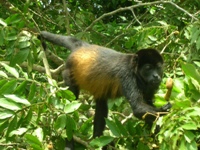
Situated on both sides of the border between Nicaragua and Honduras, the Bosawas Biosphere Reserve covers more than 2 million acres (20 000 square km) and is home to thousands of plant and animal species, and nearly 200,000 types of insect.The area was designated a UNESCO Biosphere Reserve in 1997, and is the second largest rainforest in the Western Hemisphere, second only to the Amazon in Brazil. In fact, the reserve, including buffer zones, takes up about 15% of the country's total land area.The forest is still remarkably unexplored and pristine, a dream for true nature lovers. Tourists who make the effort to visit the Bosawas Biosphere Reserve will discover a rich array of animal life, including pumas, jaguars, and the largest and most powerful eagle in the Americas, the harpy eagle.The indigenous peoples, the Sumos and the Miskito, still practice subsistence farming within the boundaries of the reserve, much as they have done for centuries. Guided treks through the forest are available from a number of reputable tour operators.
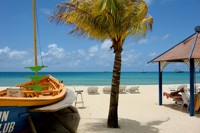
Adventurous travellers should definitely include the Corn Islands on their list of things to do in Nicaragua. Situated 40 miles (70km) from the mainland near the city of Bluefields, the two islands are home to howler monkeys, bats, and iguanas.Most of the wildlife is located beneath the waves. The seas and surrounding coral reefs are extremely popular with divers, fishing enthusiasts, and snorkelers, with barracudas, nurse sharks, spotted eagle rays, green turtles, and even hammerhead sharks cruising the waters.In the 17th century, the islands were a hideaway for pirates and smugglers. Indeed, there's still mutterings of sunken treasure and old shipwrecks. Because of a tourism in its infancy, visitors won't find modern hotels or luxury resorts on Big Corn Island and Little Corn Island.Instead, there's a wealth of unspoiled plant and animal life, with a few sparsely populated villages offering simple, inexpensive accommodation. The Corn Islands are a perfect holiday destination in Nicaragua, a tropical paradise somehow still overlooked by tourists yet offering the expected white sandy beaches and fruit trees.
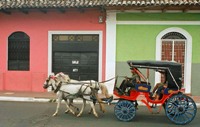
The colourful city of Granada offers visitors plenty of historical sights and beautiful colonial architecture, some of which dates back to the 1600s. Granada was founded in 1524 and is said to be the oldest city in the New World, a Spanish showpiece that still retains a regal yet dilapidated charm.Many of the historic buildings have been restored multiple times over the centuries, with residents making an effort to protect their heritage despite pirate invasions and civil wars. The city boasts some lively markets and interesting museums popular with tourists.Granada is home to a vibrant nightlife scene and a number of popular festivals, including the colourful Granada Holy Week festivities. Popular places to visit in Granada include the town's six main churches, Parque Centrale (central park), Fuerte La Polvora (an 18th-century fort), Lake Nicaragua, and the Mi Museo (a private museum).Other fun things to do in and around Granada include forest canopy tours, treks around the Massaya Volcano, shopping excursions at the town's local market, and trips to coffee. Granada is the best town for visitors to use as a base while exploring Lake Nicaragua, as well as many of the country's volcanos and beaches.
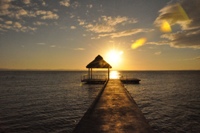
Sometimes referred to as Lake Cocibolca, Lake Nicaragua is Central America's largest lake and 10th largest body of fresh water in the world. A number of attractions apart from its size make Lake Nicaragua remarkable, spreading out beneath Mombacho Volcano.It is one of the only few freshwater bodies in the world that contains sharks. Bull sharks inhabit the depths of the lake and are a rare sight for even the most devoted spotters. Despite the lake's importance in the region, tourist infrastructure isn't necessarily up to standard.Known locally as Las Isletas, the collection of small islands scattered within the lake are believed to be the result of a volcanic eruption thousands of years ago, which spewed massive rocks out into the water. The lake is also home to the volcanic Ometepe Island with its twin volcanic peaks.Visitors to Lake Nicaragua can hire a boat and tour the islands while taking in the spectacular scenery and diverse bird and aquatic life. The cities of Granada, San Carlos, San Jorge, and San Miguelito are all located on the shores of Lake Nicaragua, making it easily accessible for tourists.
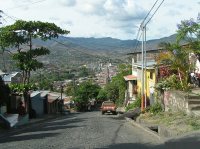
A good starting point for travellers exploring Nicaragua's mountainous regions, Matagalpa is the sixth largest city in Nicaragua and one of the most important commercial centres. Sometimes called the 'Pearl of the North' or even the 'Land of Eternal Spring', Matagalpa is surrounded by beautiful valleys and steep hills.They are home to coffee and cattle farms, traditional Indian villages, volcanoes, and waterfalls. The city has a uniquely German culture due to settlers in the region, but most of the residents speak English. Despite its size, it feels more like a village with a distinct local character and sense of community.Matagalpa is mainly attractive for tourists as a paradise for outdoor activities like hiking, bird watching, and horseback riding, and it is the city's location rather than its sightseeing attractions that make it worth visiting.Having said that, there are some interesting museums in Matagalpa and a visit to one of the coffee plantations is a must for fanatics as the region produces very high quality coffee. There is a decent shopping and restaurant scene, and a good range of accommodation to suit all budgets.
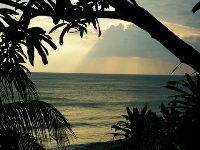
Montelimar Beach sits on the Pacific Coast of Nicaragua, offering tourists the perfect Nicaraguan beach resort experience. It is one of the most beautiful beaches in the country and is the closest to the capital city of Managua where many travellers begin their Nicaraguan visit.The Barcelo Hotel and Resort on the old Somoza Estate is a great option for those wanting an all-inclusive beach resort getaway, featuring a huge pool, said to be the largest in the country, and even a casino overlooking the sea.For those who prefer to avoid package deals and resorts, there are a few other options for accommodation near Montelimar Beach. The most popular activity in Montelimar is simply relaxing on the 1.5 mile (3km) stretch of beach made up of pristine white sand.Visitors can also enjoy the animals at the nearby zoo, or go shopping at the popular curio stalls and shops dotted throughout the area. Other things to do in this Nicaraguan resort town include scuba diving, surfing, and snorkelling. Montelimar Beach is a must for visitors seeking a stress-free holiday filled with relaxation and sun.
The National Museum in Managua is one of Nicaragua's principal tourist attractions and the city's best museum. The museum building sits imposing and attractive on the Plaza de Revolucion, where the ruined cathedral and a number of other important buildings stand.It houses a fascinating selection of artefacts and a number of displays about Central American history, ancient Central American civilisations, and the Columbus period. The museum's nine rooms contain a selection of modern art.There are also informative exhibitions about the country's turbulent natural history, including information about the numerous Nicaraguan volcanoes and earthquakes that have devastated the country over the years.The museum staff are helpful, informative, and friendly, making it an ideal attraction for any visitor wanting to learn more about Nicaragua. If you don't read or speak Spanish, it is best to take a guided tour as there is not much information in English.In fact, the tours are the best way to get to grips with all the information and bring it all to life, even if you do speak the language. Although the exhibits are not quite world class and there is certainly room for improvement, the National Museum is a fascinating place to spend a few hours.
Opening times : Monday to Friday 8am-5pm.
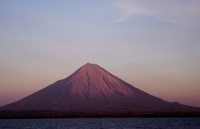
No trip to Nicaragua is complete without a hike up at least one of the country's many volcanoes. Nicaragua is home to a remarkable string running from the southern mountains around Lake Nicaragua up to the impressive northern Cosiguina Volcano, towering over the Gulf of Fonseca.Many of the Nicaraguan volcanoes are dormant. But since some remain active, it is advisable to hike the volcanoes with a guide or local tour group. Some of the more popular volcanoes include Maderas, Concepcion, Zapatera, Mombacho, Laguna de Apoyo, Masaya, Apoyeque, Momotombo, Cerro Negro, Telica, San Cristobal, and Consiguina.Maderas, Concepcion, and Zapatera rise up out of Lake Nicaragua. Zapatera stands alone while Maderas and Concepcion are located on Ometepe Island, popular climbing choices for visitors. Concepcion is an active volcano, but Maderas is dormant.Zapatera is not popular among tourists as it is difficult to reach and the volcano itself is both extinct and relatively small at 2,063 feet (629m). Mombacho Volcano lies on the banks of Lake Nicaragua and is thought to be the source of the lake's islands.Mombacho is great for hiking and it's even possible to drive to the top. The beautiful Laguna de Apoyo is a tranquil crater lake popular with hikers and swimmers. The western shore of the lake has an active fumarole emitting steam and gas.Masaya Volcano National Park is a short drive from Managua, with the smoking Masaya Volcano as its principal attraction. A paved road goes up to the crater where visitors can marvel at the white plume of smoke or try to spot the colony of green parakeets living in the crater itself.Apoyeque Volcano is also a quick trip from Managua. This volcano is extinct and water fills the crater, with visitors able to take in the spectacular surrounding scenery or cool off with a swim in the crystal clear waters of the volcano.Momotombo is the quintessential cone-shaped volcano. It is active and last erupted in 2015, after a century of inactivity. Momotombo is popular with experienced climbers and is visible from Managua, situated more than 60 miles (100km) from the Nicaraguan capital.The Nicaraguan government uses Momotombo to produce geothermal energy and electricity. Telica Volcano also erupted in 2015, with those who brave the strenuous 8-12 hour hike to its summit will be able to see molten lava glowing at the bottom of the crater.Cerro Negro Volcano last erupted in 1999 and is the youngest volcano in Central America. It has blackened slopes and is scattered with volcanic rocks. Climbing it can take about an hour and one of Cerro Negro's slopes is used for sand skiing.The 5,725-foot (1,745m) San Cristobel Volcano is Nicaragua's tallest active volcano. San Cristobel last erupted in 2008 and the entire complex consists of five smaller volcanoes. With steep slopes, it is a challenging climb and spectacular views reward those who make it to the crater.Lastly, Cosiguina Volcano offers hikers some of the most impressive views and mountain scenery. Travellers reach the crater via a forest hike or drive most of the way up. From the parking area, the hike to the crater is only three hours. The top offers panoramic views of the Gulf of Fonseca, Honduras, and El Salvador.Hiking in Nicaragua offers spectacular views and impressive landscapes, with awe-inspiring craters and splendid photographic opportunities. It's a rewarding experience for all those who make the effort on their trip to Nicaragua.
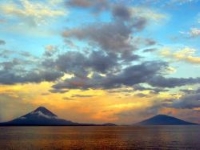
The twin volcanoes on Lake Nicaragua are highlights for visitors to the scenic country. They are situated midway between Nicaragua and Costa Rica. Visitors to the islands explore volcanoes by hiking through rainforests, while one can also pay a trip to a local coffee farm which is dependent on the fertile slopes to grow fragrant beans.Birds and wildlife delight nature lovers, while sports enthusiasts enjoy kayaking and fishing tours around the island. For those who brave hiking the 3,300 foot (1,500m) summit of one of the volcanoes, the views are unsurpassed. Visitors could easily spend a few days exploring the numerous natural attractions the islands have to offer.Boats from San Jorge, just outside Rivas, to the islands cost around NIO 50. Ferries also depart from San Carlos and Granada, costing between NIO 50 and NIO 70. They don't leave every day and are sometimes inactive due to low water levels. Ferry rides take 6 to 12 hours, depending on the point of departure, and are perfect to take in lake scenery.

Travel Guide powered by Word Travels, copyright © 2023 Globe Media Ltd. By its very nature information in this travel guide is subject to change at short notice and travellers are urged to verify information on which they're relying with the relevant authorities. Neither Globe Media Ltd nor Travel Vogue can accept any responsibility for any loss or inconvenience to any person as a result of information contained above.